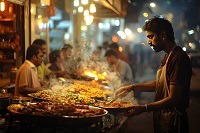- Tri Nagar Delhi -110035
- 9560598477
Street Foods Loved by Youth in India: A Flavorful Journey Through the Streets
India is a country known for its diversity, and this extends to its food culture as well. When it comes to street food, the youth in India have a deep connection. From the bustling streets of Mumbai to the lively lanes of Delhi and the colorful markets of Kolkata, street food is not just a quick snack—it’s an experience. Youngsters flock to street corners, food stalls, and dhabas to savor mouthwatering delicacies that define the essence of Indian street food. This blog explores some of the most popular street foods enjoyed by the youth of India, the reasons behind their love for these foods, and how street food culture is evolving in modern India.
The Appeal of Street Food Among Youth in India
Street food holds a special place in the hearts of young Indians, and it’s easy to understand why. For many, it’s not just about food—it’s about the whole experience: the lively ambiance, the aroma of spices, the interaction with vendors, and, of course, the satisfaction of enjoying a delicious meal at a fraction of the price one would pay at a restaurant.
Accessibility and Affordability
One of the primary reasons why street food is so loved by the youth in India is its accessibility and affordability. Street food vendors are found on almost every street corner, at marketplaces, and near colleges or offices. They offer a variety of snacks that can fit anyone’s budget. Whether it’s a plate of chaat for ₹20 or a full meal for ₹100, street food makes delicious dining accessible to all.
Social and Cultural Experience
Street food is more than just eating; it’s a social activity. Youngsters enjoy gathering with friends and chatting over a plate of piping hot samosas or golgappas. Many street food items are meant to be shared, making them ideal for group outings or late-night hangouts. The variety, the explosion of flavors, and the friendly banter with food vendors make the entire experience memorable.
Fusion and Innovation
As food trends evolve, so do street food offerings. Today, many street food vendors are experimenting with fusion flavors, combining traditional Indian snacks with international ingredients or styles. This fusion has attracted the younger crowd, who are always on the lookout for innovative and trendy food options.
Top Street Foods Liked by Youth in India
Indian street food is a rainbow of flavors, textures, and aromas. Some items have become so popular that they transcend regional boundaries. Below are some of the most beloved street foods that have captured the hearts of India’s youth.
- Pani Puri/Golgappa
No list of popular street food is complete without mentioning Pani Puri (also known as Golgappa or Phuchkas). This iconic snack is a favorite among the youth for its tangy, spicy, and refreshing taste. Made from crispy puris filled with spicy water, tamarind chutney, and potato stuffing, pani puri is a perfect example of the harmony of flavors that youth love. Whether it’s served in Kolkata, Delhi, or Mumbai, each region has its variation, but the essence remains the same: a burst of flavors in every bite.
- Samosa
The samosa is a timeless street food snack that has found its way into the hearts of millions. A crispy pastry filled with spiced potatoes, peas, and sometimes meat, samosas are enjoyed by people of all ages, especially the youth. Whether paired with tangy chutneys or eaten as a quick snack with a cup of chai, samosas are often the go-to food for quick breaks, parties, and celebrations.
- Vada Pav
Vada Pav, often referred to as the ‘Indian burger,’ is a favorite in Mumbai but has also found fans across the country. A spicy batata vada (fried potato patty) is placed inside a pav (bread bun), accompanied by chutneys and fried green chilies. This street food is not only budget-friendly but also filling and packed with flavors, making it a go-to choice for college students, office-goers, and anyone looking for a quick, delicious meal.
- Chaat (Aloo Tikki, Dahi Puri, Bhel Puri)
Chaat is an umbrella term for a variety of snacks that are a favorite in India, especially among the youth. Some of the most popular chaat varieties include:
- Aloo Tikki Chaat: A deep-fried potato patty topped with yogurt, tamarind chutney, and spices.
- Dahi Puri: A variation of pani puri where the puris are stuffed with yogurt and tamarind chutney.
- Bhel Puri: A crunchy, spicy mix of puffed rice, sev (crunchy noodles), vegetables, and tangy chutneys.
Chaat is often enjoyed as a snack during evening outings or gatherings, with young people lining up at street vendors to indulge in this delightful mix of flavors and textures.
- Kathi Roll
Originating in Kolkata, the Kathi Roll has quickly become a favorite across India, especially among the youth. A filling of spiced chicken, paneer, or vegetables is rolled up in a paratha (flatbread) along with onions, sauces, and chutneys. It’s easy to carry, affordable, and packed with flavors, making it a perfect snack for people on the go.
- Pav Bhaji
Pav Bhaji is a popular street food in Mumbai but has gained a strong fan base across the country. The dish consists of a spiced vegetable mash (bhaji) served with buttered pav (bread rolls). The bhaji is rich in flavor, and the pav adds a soft, buttery texture that complements the spicy mix. It’s a hearty meal, often enjoyed in the evenings or at late-night food stalls.
- Maggi
While not strictly a traditional street food, Maggi noodles have become synonymous with quick and easy snacks in India. Available at nearly every street corner, Maggi has evolved from being a simple noodle dish to a customized street food item. From adding vegetables, cheese, or even fried eggs to the noodles, the possibilities are endless. It’s a staple for late-night munching and a favorite of college students and young professionals.
Why Are These Street Foods So Popular Among the Youth?
Street foods like pani puri, vada pav, and samosas have earned their place in the hearts of young Indians for several reasons:
- Convenience and Accessibility
Most street food vendors are located near colleges, office hubs, and busy marketplaces, making these snacks easy to access. The convenience of grabbing a quick bite while on the move makes street food the preferred choice for busy youth.
- Affordable Price
Street food is incredibly affordable. With a modest budget, one can enjoy a satisfying meal or snack. For many young people, especially students and early career professionals, this affordability plays a big role in making street food an everyday indulgence.
- Variety and Customization
The sheer variety of options—from spicy to tangy, fried to grilled—makes street food an attractive choice. Additionally, many vendors allow customization, whether it’s adjusting the spice levels, adding extra chutney, or picking the type of filling, making the food even more appealing.
- Social Experience
Eating street food is often a social event. Young people gather with friends to enjoy food, chat, and relax. Many street food vendors become local hangout spots for youth, contributing to the sense of community and social bonding.
- Nostalgia and Tradition
For many young Indians, street food represents a connection to their roots. Whether it’s a family tradition of eating chaat on a Sunday evening or grabbing vada pav after college, these foods evoke nostalgia and maintain a strong cultural connection.
The Evolution of Street Food Culture in India
While street food has always been a part of Indian culture, its role and presentation have evolved in recent years. Several factors are shaping the future of street food in India.
- Health-Conscious Options
With increasing awareness about health and nutrition, many street food vendors are now offering healthier alternatives, such as whole grain wraps, low-oil snacks, and vegetarian options. Additionally, some vendors are using organic ingredients and less sugar, catering to the growing demand for health-conscious food choices.
- Fusion Street Foods
Young people today are more experimental with food, and this has led to the rise of fusion street food. From pizza dosa to burger pav, vendors are combining global food trends with local ingredients to create exciting and novel dishes. These fusion foods cater to a younger crowd eager to try something new.
- Food Trucks and Gourmet Street Food
In urban areas, gourmet street food trucks have begun to take the traditional street food experience to the next level. These food trucks offer high-quality ingredients, a clean environment, and unique fusion dishes that cater to the taste of modern youth.
- Online Food Delivery Platforms
With the rise of online food delivery services like Zomato and Swiggy, street food is now available at the fingertips of young people, even if they are not able to go out to the streets. Many street food vendors have adapted to these platforms, reaching an even broader audience.
Conclusion
Street food in India is more than just a quick meal—it’s an experience that brings people together, offers a taste of tradition, and introduces exciting new flavors. From pani puri to pav bhaji, the youth of India have embraced these flavors and made them an integral part of their daily lives. Whether it’s the affordability, accessibility, or the sheer variety of choices, street food offers something for everyone.
As Indian street food continues to evolve and adapt to modern trends, one thing remains constant: its ability to bring joy to the people, one bite at a time. For young people in India, street food is not just food—it’s a connection to culture, memories, and the vibrant spirit of the streets.






